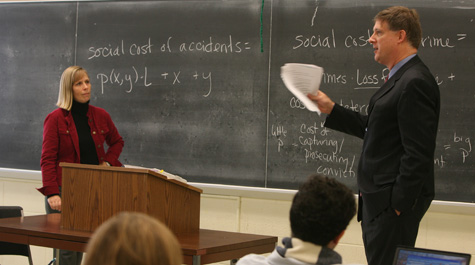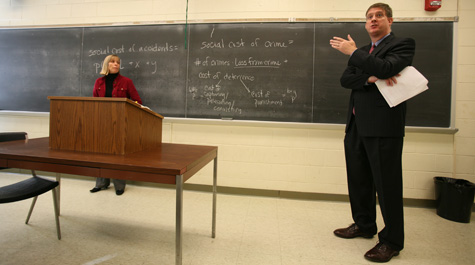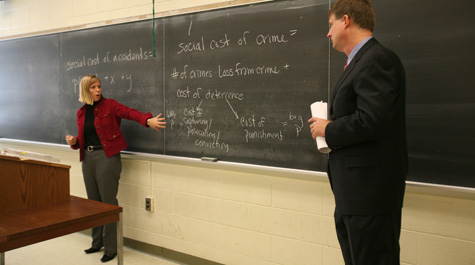Meese and Stafford Team Up To Teach Law and Economics Courses
A pair of professors at William & Mary recently teamed up to teach two classes in an interdisciplinary experiment involving the College's law school and its economics department.
Alan Meese, Ball Professor of Law, and Sarah Stafford, the Paul Verkuil Associate Professor of Public Policy and Economics, co-taught two courses during the fall 2009 semester. Both courses were titled "Economic Analyses of the Law" but one was taught to graduate students at the William & Mary Law School and one was taught to undergraduates in the College's economics department.
"This collaboration between professors across schools is an excellent example of the College's commitment to interdisciplinary work and aligns fully with our strategic plan in this arena," said Provost Michael Halleran.
The courses sought to address questions such as: should the state increase criminal punishments whenever doing so reduces crime; when, if ever, can the state or a private party use or even take your property without your consent; and when, if ever, should an accident victim have to prove that the injuring party was at fault to recover damages. In each course, Stafford and Meese employed the tools of economic analysis to answer these and other questions, confident that economic theory could help explain the content of legal rules and in some cases suggest room for improvement.
Stafford explained: "The courses explored the general hypothesis that economic logic informs the salient aspects of various bodies of law --- both statutory and judge-made. It turns out that most major attributes of the bodies of law we studied can be explained by a desire to enhance society's welfare by encouraging the efficient use of resources."
Meese has taught the course to law students and Stafford has taught the course to undergraduate students for many years, but last year was the first time they combined their efforts. The idea originated with Eric Kades, vice dean and professor of law, who is "very interested in fostering interdisciplinary connections between the law school and other parts of campus," said Meese.
"Many faculty in the Law School and in the Arts and Sciences believe that both students and faculty can reap significant benefits from combining insights from law, social science, the humanities, and even the sciences," said Kades. "Alan and Sarah were ideal professors for this experiment in interdisciplinary teaching: incredibly smart, agile at the podium, and open to multiple perspectives. By all reports, the students thoroughly enjoyed both classes. Given this initial success, we are looking to expand this type of interdisciplinary offering."
"When Eric approached us about this, I thought, oh, that would be really fun! I'd seen (Meese) teach, and I like the way he teaches and I thought it would just be really fun to be in the classroom with him," said Stafford.
Although the two professors are very different people with everything from opposing political views to radically different vehicle choices, they soon found that they worked together quite well. They sent each other notes before each class and then met prior to class to discuss what they'd be doing that day. Their biggest challenge turned out not to be curriculum or teaching styles, but day-to-day class management.
"When you've got two people up there who are both thinking about what's going on and who've both taught the course themselves and all by themselves, and one of them is doing most of the talking, it's hard to know when to interrupt and when not to interrupt," said Meese.
The students, too, had to do some adjusting to having two professors in front of the class. At first, the professors noticed that students often looked back and forth between the two of them, unsure of whose eye to catch to ask a question.
"They're not entirely sure what this situation is with two professors at the front of the room -- which one has the authority to answer questions and whose answer do I trust?" said Stafford.
But as the semester rolled on and the professors hit their stride together, it became apparent that the students were comfortable interacting with both of them.
Except, that is, when the two age peers made references to popular culture from their generation.
"We tend to use references that the two of us get and are sometimes completely lost on our students. But because we're both there reinforcing them, we don't really realize until all these blank looks come up at us," said Stafford.
Unfamiliar pop culture references aside, students seemed to like having both professors in the classroom.
Kathleen Parks, a 3rd year law student, said that "having someone coming from a different discipline come in an explain things from a different perspective was interesting."
"I enjoyed having a class that was co-taught because it provided us with two different perspectives on the topics we discussed and two different perspectives on how to approach and answer the question of why something we studied was the way it was," she said.
Parks, who said she enjoyed economics as an undergraduate, "loved having an economist teaching in a law school class."
She added, "given my background interest in the subject, having an economist teach a law class was an unexpected treat."
Messe said that he thinks collaborations such as this are beneficial to students.
"William and Mary --- America's first university --- is a true university, and we can integrate the strengths of law school and the arts & sciences," said Meese. "Such integration can produce a better product for our students."
Stafford agreed: "Seeing things from an interdisciplinary perspective in class is a useful preview of what the students will encounter in their future careers. Many of the undergraduates will be going to law school or working in careers where they regularly encounter lawyers while many of the law students will be working on cases or in positions where economic issues and concepts are important."
Though the two professors are not co-teaching this semester, they both said it is something they'd be willing to do again, given the right partner. It has helped both of them improve not only as teachers, but as scholars, as well.
"There is a synergy between teaching and scholarship," said Meese. "We are both active researchers and productive scholars, and our scholarship strengthens our teaching and vice versa. There is an additional synergy when you have folks from overlapping but distinct disciplines addressing similar problems and issues from their own unique perspectives. Speaking for myself, teaching with an economist has certainly enhanced my understanding of certain concepts in a way that will enhance the quality of my scholarship."
Stafford, who joined the faculty in 1998, also teaches courses on industrial organization, environmental economics, government regulation of business and regulation of markets. Her research focuses on the economics of environmental regulation, particularly the efficacy of various policies designed to improve compliance with the nation's environmental laws. She has also written about universities' compliance with Title IX and rent seeking under varying competitive conditions.
Meese, who joined the faculty in 1995, also teaches courses on antitrust law and constitutional law, as well as torts and corporations. His research examines the economics of antitrust policy, and he has also written on the economics of tort law and corporate law.



